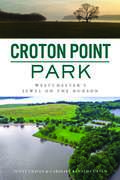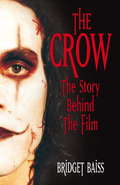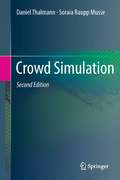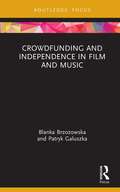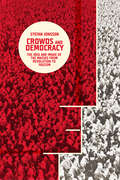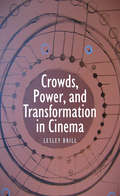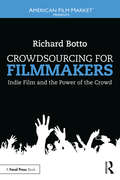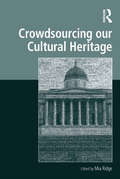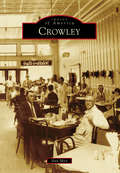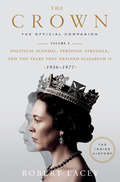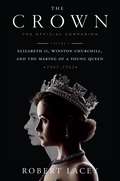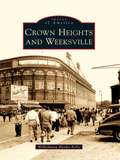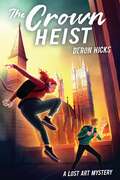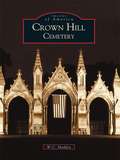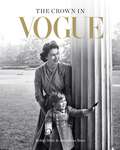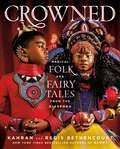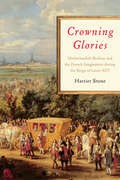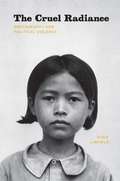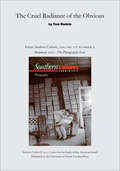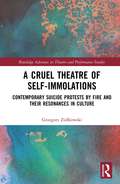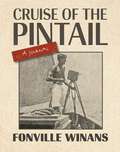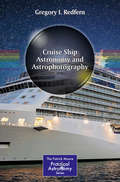- Table View
- List View
Crossroads of Culture: Anthropology Collections at the Denver Museum of Nature & Science
by Chip Colwell Stephen E. Nash Steven R. HolenThe hectic front of the Denver Museum of Nature & Science hides an unseen back of the museum that is also bustling. Less than 1 percent of the museum's collections are on display at any given time, and the Department of Anthropology alone cares for more than 50,000 objects from every corner of the globe not normally available to the public. This lavishly illustrated book presents and celebrates the Denver Museum of Nature & Science's exceptional anthropology collections for the first time. The book presents 123 full-color images to highlight the museum's cultural treasures. Selected for their individual beauty, historic value, and cultural meaning, these objects connect different places, times, and people. From the mammoth hunters of the Plains to the first American pioneer settlers to the flourishing Hispanic and Asian diasporas in downtown Denver, the Rocky Mountain region has been home to a breathtaking array of cultures. Many objects tell this story of the Rocky Mountains' fascinating and complex past, whereas others serve to bring enigmatic corners of the globe to modern-day Denver. Crossroads of Culture serves as a behind-the-scenes tour of the museum's anthropology collections. All the royalties from this publication will benefit the collections of the Denver Museum of Nature & Science's Department of Anthropology.
Croton Point Park: Westchester’s Jewel on the Hudson (Landmarks)
by Scott Craven Caroline Ranald CurvanLess than an hour by train from New York City...Croton Point Park encapsulates the history, beauty and promise of the Hudson Valley. The Westchester County Park encompasses miles of Hudson River shoreline with astonishing views and remnants of the region's past. Incredible shell mounds shed light on the Native peoples who inhabited the area generations prior to European colonization. The remains of the first commercial vineyards in the Northeast are just steps away from historic brickyards that helped build Manhattan. The Point served as a dumping ground for years until local efforts restored the park into a model of environmental conservation. Today, bald eagles have returned to nest alongside visitors exploring remarkable landmarks, sailing the waters of the Hudson or enjoying a scenic picnic. Authors Scott Craven and Caroline Ranald Curvan present Westchester's crown jewel, Croton Point Park.
The Crow: The Story Behind the Film
by Bridget BaissOn 31 March 1993, with production on The Crow nearing completion, the film's twenty-eight year-old star Brandon Lee (son of Bruce Lee) was accidentally shot and killed while filming his character's death scene. More than a year later, on Friday 13 May 1994, using body doubles and digital effects, and with the consent of Lee's family, the film was finally completed and released -- and immediately went to number one at the US box office. Now The Crow has become a worldwide phenomenon. Using scores of interviews with the cast and crew, including Crow creator James O'Barr, Bridget Baiss provides the definitive account of the making of the Crow movie. From the creation of the graphic novel (itself inspired by a personal bereavement) and its adaptation as a screenplay, through to the premature and controversial death of Brandon Lee and the film's release, every aspect of this ultimate cult movie is chronicled. Book jacket.
Crowd Simulation
by Daniel Thalmann Soraia Raupp MusseResearch into the methods and techniques used in simulating crowds has developed extensively within the last few years, particularly in the areas of video games and film. Despite recent impressive results when simulating and rendering thousands of individuals, many challenges still exist in this area. The comparison of simulation with reality, the realistic appearance of virtual humans and their behavior, group structure and their motion, and collision avoidance are just some examples of these challenges. For most of the applications of crowds, it is now a requirement to have real-time simulations - which is an additional challenge, particularly when crowds are very large. Crowd Simulation analyses these challenges in depth and suggests many possible solutions. Daniel Thalmann and Soraia Musse share their experiences and expertise in the application of: · Population modeling · Virtual human animation · Behavioral models for crowds · The connection between virtual and real crowds · Path planning and navigation · Visual attention models · Geometric and populated semantic environments · Crowd rendering The second edition presents techniques and methods developed since the authors first covered the simulation of crowds in 2007. Crowd Simulation includes in-depth discussions on the techniques of path planning, including a new hybrid approach between navigation graphs and potential-based methods. The importance of gaze attention - individuals appearing conscious of their environment and of others - is introduced, and a free-of-collision method for crowds is also discussed.
Crowdfunding and Independence in Film and Music (Routledge Focus on Media and Cultural Studies)
by Blanka Brzozowska Patryk GaluszkaThis book explores how independent film and music artists and labels use crowdfunding and where this use places crowdfunding in the contemporary system of cultural production. It complements an analysis of independence in film and music with the topic of crowdfunding as a firmly established form of financing cultural activity. In the second half of the 20th century, the concept of artistic independence was vital to classifying and distinguishing artists, their works, and labels or publishers who released them. However, during the last three decades, this term has become increasingly blurred, and some commentators argue that independence is in crisis. Can crowdfunding be the answer to this crisis? Some believe that it is, whereas others argue otherwise, seeing crowdfunding instead as just the next manifestation of this crisis. This dilemma is a starting point for the analyses of the relationships between crowdfunding and artistic independence conducted in this book, and will be of great interest to people looking for a deeper understanding of crowdfunding, how it can influence artistic independence, and what it means for artists and audiences. It will be a stimulating read for scholars and students with an interest in media and cultural studies, digital humanities, fandom, sociology, economics, business studies, and law, while also offering insights to artists and practitioners in the creative industries.
Crowds and Democracy: The Idea and Image of the Masses from Revolution to Fascism (Columbia Themes in Philosophy, Social Criticism, and the Arts)
by Stefan JonssonBetween 1918 and 1933, the masses became a decisive preoccupation of European culture, fueling modernist movements in art, literature, architecture, theater, and cinema, as well as the rise of communism and fascism and experiments in radical democracy. Spanning aesthetics, cultural studies, intellectual history, and political theory, this volume unpacks the significance of the shadow agent known as "the mass" during a critical period in European history. It follows its evolution into the preferred conceptual tool for social scientists, the ideal slogan for politicians, and the chosen image for artists and writers trying to capture a society in flux and a people in upheaval. This volume is the second installment in Stefan Jonsson's epic study of the crowd and the mass in modern Europe, building on his work in A Brief History of the Masses, which focused on monumental artworks produced in 1789, 1889, and 1989.
Crowds and Democracy
by Stefan JonssonBetween 1913 and 1933, the masses became a decisive preoccupation of European culture, fueling modernist movements in art, literature, architecture, theater, and cinema, as well as the rise of communism, fascism, and experiments in radical democracy. Spanning aesthetics, cultural studies, intellectual history, and political theory, this volume unpacks the significance of the shadow agent known as "the mass" during a critical period in European history. It follows its evolution into the preferred conceptual tool for social scientists, the ideal slogan for politicians, and the chosen image for artists and writers trying to capture a society in flux and a people in upheaval. This volume is the second installment in Stefan Jonsson's epic study of the crowd and the mass in modern Europe, building on his work in A Brief History of the Masses, which focused on monumental artworks produced in 1789, 1889, and 1989.
Crowds, Power, and Transformation in Cinema
by Lesley BrillA noted critic brings crowd theory to Film Studies, offering a bold new analysis of the pervasive cinematic themes of transformation and power.
Crowdsourcing for Filmmakers: Indie Film and the Power of the Crowd (American Film Market Presents)
by Richard BottoWhether you’re a producer, screenwriter, filmmaker, or other creative, you probably have a project that needs constant exposure, or a product to promote. But how do you rise above the noise? In Crowdsourcing for Filmmakers: Indie Film and the Power of the Crowd, Richard Botto explains how to put crowdsourcing to use for your creative project, using social media, networking, branding, crowdfunding, and an understanding of your audience to build effective crowdsourcing campaigns, sourcing everything from film equipment to shooting locations. Botto covers all aspects of crowdsourcing: how to create the message of your brand, project, or initiative; how to mold, shape, and adjust it based on mass response; how to broadcast a message to a targeted group and engage those with similar likes, beliefs, or interests; and finally, how to cultivate those relationships to the point where the message is no longer put forth solely by you, but carried and broadcasted by those who have responded to it. Using a wealth of case studies and practical know-how based on his years of experience in the industry and as founder of Stage 32—the largest crowdsourced platform for film creatives—Richard Botto presents a comprehensive and hands-on guide to crowdsourcing creatively and expertly putting your audience to work on your behalf.
Crowdsourcing our Cultural Heritage (Digital Research in the Arts and Humanities)
by Mia RidgeCrowdsourcing, or asking the general public to help contribute to shared goals, is increasingly popular in memory institutions as a tool for digitising or computing vast amounts of data. This book brings together for the first time the collected wisdom of international leaders in the theory and practice of crowdsourcing in cultural heritage. It features eight accessible case studies of groundbreaking projects from leading cultural heritage and academic institutions, and four thought-provoking essays that reflect on the wider implications of this engagement for participants and on the institutions themselves. Crowdsourcing in cultural heritage is more than a framework for creating content: as a form of mutually beneficial engagement with the collections and research of museums, libraries, archives and academia, it benefits both audiences and institutions. However, successful crowdsourcing projects reflect a commitment to developing effective interface and technical designs. This book will help practitioners who wish to create their own crowdsourcing projects understand how other institutions devised the right combination of source material and the tasks for their ’crowd’. The authors provide theoretically informed, actionable insights on crowdsourcing in cultural heritage, outlining the context in which their projects were created, the challenges and opportunities that informed decisions during implementation, and reflecting on the results. This book will be essential reading for information and cultural management professionals, students and researchers in universities, corporate, public or academic libraries, museums and archives.
Crowley
by Ann MireHow do you build a town from scratch? The first ingredient is a dream. W.W. Duson served as the chef with a vision for a new town. With the railroad completed through southwestern Louisiana in 1881, Duson, general manager of the Southwestern Louisiana Land Company, orchestrated the purchase of land along the railroad. Railroader Patrick Crowley moved his "Crowley Switch" house depot to the new townsite as Duson stirred interest through advertisements in Midwestern newspapers. Duson blended the surveying, bringing 100 workers to clear the land, with Duson Brothers' real estate business to help shape the town. Mixed in were special excursion trains that brought in prospective buyers of lots and farmland. Finally, a heaping helping of pioneer adventurers--including merchant Jac Frankel, physician D.P. January, farmer brothers C.J. and Thomas Freeland, attorney James Barry, banker Preston Lovell, and many others--were added to spice up the town.
The Crown: Political Scandal, Personal Struggle, and the Years that Defined Elizabeth II (1956-1977) (The Crown #2)
by Robert LaceyThe fascinating royal and social history that inspired seasons 2 and 3 of The Crown, written by the show&’s historical consultant. In this eye-opening companion to seasons 2 and 3 of Netflix&’s acclaimed series The Crown, renowned biographer—and the show&’s historical consultant—Robert Lacey takes us through the real history that inspired the drama. Covering two tumultuous decades in the reign of Queen Elizabeth II, Lacey looks at the key social, political, and personal moments and their effects—not only on the royal family but also on the world around them. From the Suez Crisis and the U.S.–Soviet space race to the legacy of the Duke of Windsor&’s collaboration with Hitler, along with the rumored issues with the royal marriage, the book provides a thought-provoking insight into the historic decades that the show explores, revealing the truth behind the on-screen drama. Extensively researched and complete with beautifully reproduced photographs, this is a unique look behind the history that inspired the show and the years that would prove to be the making of the Queen.The Crown is now available to watch on Netflix.The Crown is produced by Left Bank Pictures in association with Sony Pictures Television for Netflix.
The Crown: The Official Companion, Volume 1: Elizabeth II, Winston Churchill, and the Making of a Young Queen (1947-1955) (The Crown #1)
by Robert LaceyThe official companion to the Emmy-winning Netflix drama chronicling the reign of Queen Elizabeth II, and starring Claire Foy and John Lithgow, The Crown by Peter Morgan, featuring additional historical background and beautifully reproduced archival photos and show stills <P><P>Elizabeth Mountbatten never expected her father to die so suddenly, so young, leaving her with a throne to fill and a global institution to govern. <P>Crowned at twenty-five, she was already a wife and mother as she began her journey towards becoming a queen. <P> As Britain lifted itself out of the shadow of war, the new monarch faced her own challenges. <P>Her mother doubted her marriage; her uncle-in-exile derided her abilities; her husband resented the sacrifice of his career and family name; and her rebellious sister embarked on a love affair that threatened the centuries-old links between the Church and the Crown. <P>This is the story of how Elizabeth II drew on every ounce of resolve to ensure that the Crown always came out on top. <P>Written by the show’s historical consultant, royal biographer Robert Lacey, and filled with beautifully reproduced archival photos and show stills, The Crown: The Official Companion: Volume 1 adds expert and in-depth detail to the events of the series, painting an intimate portrait of life inside Buckingham Palace and 10 Downing Street. <P>Here is Elizabeth II as we’ve never seen her before.
Crown Heights and Weeksville (Images of America)
by Wilhelmena Rhodes KellyThe communities of Crown Heights and Weeksville are historically significant Brooklyn neighborhoods with foundations that trace back to New York's early founding. Revolutionary War skirmishes took place there, and following the emancipation of slaves in 1827, Weeksville became the site of one of New York's earliest independent African American townships. The hills of Brooklyn's Green Mountains hindered early settlement, and as a result a plethora of community institutions instead abounded in this far-flung outpost, including a penitentiary, hospitals, almshouses, old-age homes, convents, and monasteries. Traces of some of these early structures still remain. Using vintage images, Crown Heights and Weeksville chronicles the dynamic evolution of this area from rural township to the desirable center of culture, urban convenience, and architectural beauty.
The Crown Heist (The Lost Art Mysteries)
by Deron R. HicksIn another "suspenseful mystery romp with art appreciation" (Kirkus Reviews, starred review), Art and Camille head to London to find her estranged father, and soon find themselves embroiled in a heist involving a long-dead monarch. Packed with fascinating facts about real places and pieces of art, this fast-paced thriller is perfect for fans of the Spy School and Mr. Limoncello's Library series and Dan Brown.No matter how dangerous his adventures have been, Art has always been able to count on his best friend, Camille. Now that Camille is meeting her estranged father, Art wants to be there for her—which means going to London. But Camille's history professor father, renowned for expertise in British legend, is missing. When they visit his apartment, Art and Camille find a long-missing object that suggests the professor could be in trouble and solving a mystery related to London's history. Follow Art and Camille as they visit the Tower of London, National Portrait Gallery, and ride the "tube" in hopes of uncovering the truth before it's too late.
Crown Hill Cemetery
by W. C. MaddenIndianapolis' Crown Hill Cemetery is noted for its unique beauty and historic significance. Dedicated on June 1, 1864, the cemetery, at more than 555 acres, is the final resting-place to over 185,000 citizens and is one of the most historically significant areas in the city. Many of the country's great leaders, soldiers, entrepreneurs, and artists are buried within the cemetery's confines including: President Benjamin Harrison, Col. Eli Lilly, and the infamous John Dillinger, to name just a few. Within these pages of vintage photographs, the history and beauty of Crown Hill Cemetery is revealed. Author W.C. Madden examines such structures as the inspiring Waiting Station and Gothic Chapel, both of which were built in the 1800s. He also details the ground's viscerahl history exemplified by the National Cemetery, dedicated to those who served our country, and the Confederate lot on the cemetery's south grounds.
The Crown in Vogue: Vogue's 'special royal salute' to Queen Elizabeth II and the House of Windsor
by Robin Muir Josephine RossA lavishly illustrated celebration of the 70-year reign of Queen Elizabeth II and the British Royal Family from the unrivalled archive of British Vogue.'Vogue, like the royal family, has been through many evolutions of its own, and to view Her Majesty's life though the record of our pages is truly a document of history.' - Edward Enninful, Editor-in-Chief of British VogueFour monarchs (crowned and uncrowned); one abdication; one royal investiture; a jewel box of jubilees and many, many royal marriages... British Vogue has borne witness to a century of royal history. The Crown in Vogue is the magazine's 'special royal salute' to our longest serving monarch and her 'assured and unwavering' presence in the lives of a nation.Vogue's first star photographer, Cecil Beaton, was entranced by the House of Windsor and the admiration was mutual. A younger star photographer, Antony Armstrong Jones, left Vogue to marry the Queen's sister and returned as Lord Snowdon. The Queen's cousin, Vogue's Lord Lichfield proved an insightful photographer of royal style along with many of Vogue's fashion photographers including Horst, Norman Parkinson and David Bailey. With visual treasures from Vogue's unrivalled archive and contributions through the decades from the most perceptive of royal commentators - from Evelyn Waugh to Zadie Smith - The Crown in Vogue is the definitive, authoritative portrait of Queen Elizabeth II's magnificent reign - and of royalty in the modern age.
The Crown in Vogue: Vogue's 'special royal salute' to Queen Elizabeth II and the House of Windsor
by Robin Muir Josephine RossA lavishly illustrated celebration of the 70-year reign of Queen Elizabeth II and the British Royal Family from the unrivalled archive of British Vogue.'Vogue, like the royal family, has been through many evolutions of its own, and to view Her Majesty's life though the record of our pages is truly a document of history.' - Edward Enninful, Editor-in-Chief of British VogueFour monarchs (crowned and uncrowned); one abdication; one royal investiture; a jewel box of jubilees and many, many royal marriages... British Vogue has borne witness to a century of royal history. The Crown in Vogue is the magazine's 'special royal salute' to our longest serving monarch and her 'assured and unwavering' presence in the lives of a nation.Vogue's first star photographer, Cecil Beaton, was entranced by the House of Windsor and the admiration was mutual. A younger star photographer, Antony Armstrong Jones, left Vogue to marry the Queen's sister and returned as Lord Snowdon. The Queen's cousin, Vogue's Lord Lichfield proved an insightful photographer of royal style along with many of Vogue's fashion photographers including Horst, Norman Parkinson and David Bailey. With visual treasures from Vogue's unrivalled archive and contributions through the decades from the most perceptive of royal commentators - from Evelyn Waugh to Zadie Smith - The Crown in Vogue is the definitive, authoritative portrait of Queen Elizabeth II's magnificent reign - and of royalty in the modern age.
CROWNED: Magical Folk and Fairy Tales from the Diaspora
by Kahran Bethencourt Regis BethencourtFrom the New York Times bestselling duo who brought you GLORY: Magical Visions of Black Beauty, comes CROWNED: Magical Folk and Fairy Tales from the Diaspora. Filled with visual magic and storytelling wonder, these stories reimagine our favorite and most beloved childhood fairy tales and folktales to encourage creativity, empower imagination, and foster self-esteem. <p><p>With a Foreword by Pulitzer Prize winner Salamishah TilletRevisit beloved classics, but with a twist, such as The Little Mermaid, Sleeping Beauty, Hansel and Gretel, Red Riding Hood, The Poisoned Apple, and find new favorites with stories created especially for the collection: Anansi and the Three Trials, Aku the Sun Maker, How the Zebra Got Its Stripes, The Legend of Princess Yennenga, and John Henry, the Steel-Drivin' Man. <p><p>A gift that will keep giving, CROWNED is a joyous celebration of Black beauty, determination, and imagination and a must-have for children and parents everywhere. <p> <b>New York Times Bestseller</b>
Crowning Glories: Netherlandish Realism and the French Imagination during the Reign of Louis XIV
by Harriet StoneCrowning Glories integrates Louis XIV’s propaganda campaigns, the transmission of Northern art into France, and the rise of empiricism in the eighteenth century – three historical touchstones – to examine what it would have meant for France’s elite to experience the arts in France simultaneously with Netherlandish realist painting. In an expansive study of cultural life under the Sun King, Harriet Stone considers the monarchy’s elaborate palace decors, the court’s official records, and the classical theatre alongside Northern images of daily life in private homes, urban markets, and country fields. Stone argues that Netherlandish art assumes an unobtrusive yet, for the history of ideas, surprisingly dramatic role within the flourishing of the arts, both visual and textual, in France during Louis XIV’s reign. Netherlandish realist art represented thinking about knowledge that challenged the monarchy’s hold on the French imagination, and its efforts to impose the king’s portrait as an ideal and proof of his authority. As objects appreciated for their aesthetic and market value, Northern realist paintings assumed an uncontroversial place in French royal and elite collections. Flemish and Dutch still lifes, genre paintings, and cityscapes, however, were not merely accoutrements of power, acquisitions made by those with influence and money. Crowning Glories reveals how the empirical orientation of Netherlandish realism exposed French court society to a radically different mode of thought, one that would gain full expression in the Encyclopédie of Diderot and d’Alembert.
The Cruel Radiance: Photography and Political Violence
by Susie LinfieldIn The Cruel Radiance, Susie Linfield challenges the idea that photographs of political violence exploit their subjects and pander to the voyeuristic tendencies of their viewers. Instead she argues passionately that looking at such images--and learning to see the people in them--is an ethically and politically necessary act that connects us to our modern history of violence and probes the human capacity for cruelty. Grappling with critics from Walter Benjamin and Bertolt Brecht to Susan Sontag and the postmoderns--and analyzing photographs from such events as the Holocaust, China's Cultural Revolution, and recent terrorist acts--Linfield explores the complex connection between photojournalism and the rise of human rights ideals. In the book's concluding section, she examines the indispensable work of Robert Capa, James Nachtwey, and Gilles Peress and asks how photography should respond to the increasingly nihilistic trajectory of modern warfare. A bracing and unsettling book, The Cruel Radiance convincingly demonstrates that if we hope to alleviate political violence, we must first truly understand it--and to do that, we must begin to look.
The Cruel Radiance of the Obvious
by Tom RankinThis introductory essay uses William Eggleston as the point of entry to preview the entire photography issue and includes striking photographs from Ansel Adams, Walker Evans, Dorothea Lange, and Susan Harbage Page—as well as exploring the stunning work of Paul Kwilecki. "Photography in its finest and most decisive moments is about those tired or ignored or unseen parts of our lives, the mundane and worn paths that sit before us so firmly that we cease to notice. It is, we might say, about rebuilding our sight in the face of blindness, of recovering our collective vision." This article appears in the Summer 2011 issue of Southern Cultures: The Photography Issue.
A Cruel Theatre of Self-Immolations: Contemporary Suicide Protests by Fire and Their Resonances in Culture (Routledge Advances in Theatre & Performance Studies)
by Grzegorz ZiółkowskiA Cruel Theatre of Self-Immolations investigates contemporary protest self-burnings and their echoes across culture. The book provides a conceptual frame for the phenomenon and an annotated, comprehensive timeline of suicide protests by fire, supplemented with notes on artworks inspired by or devoted to individual cases. The core of the publication consists of six case studies of these ultimate acts, augmented with analyses and interpretations hailing from the visual arts, film, theatre, architecture, and literature. By examining responses to these events within an interdisciplinary frame, Ziółkowski highlights the phenomenon’s global reach and creates a broad, yet in-depth, exploration of the problems that most often prompt these self-burnings, such as religious discrimination and harassment, war and its horrors, the brutality and indoctrination of authoritarian regimes and the apathy they produce, as well as the exploitation of the so-called "subalterns" and their exclusion from mainstream economic systems. Of interest to scholars from an array of fields, from theatre and performance, to visual art, to religion and politics, A Cruel Theatre of Self-Immolations offers a unique look at voluntary, demonstrative, and radical performances of shock and subversion.
Cruise of the Pintail: A Journal (The Hill Collection: Holdings of the LSU Libraries)
by Robert L. Winans James R. TurnerIn 1932 a young Fonville Winans (1911--1992) left his home in Fort Worth and set out on the waterways of south Louisiana searching for adventure and fortune. This journal recounts, in his own words, how the now-renowned photographer and his two friends -- first mate Bob Owen and second mate Don Horridge -- ventured onto untamed Louisiana waters aboard a leaking, rudderless sailboat, the Pintail. Fonville was shooting footage for a movie that he felt certain would make them rich and famous, telling the story of subtropical south Louisiana's remote coastal landscapes and its curious people. The project was ambitious and risky -- just the right combination for three young Texans with hopes of stardom. Developing his photographic skill, Fonville traveled during the summers of 1932 and 1934 to swamps, barrier islands, and reefs, from Grand Isle to New Orleans to the Atchafalaya, making friends and taking pictures. The journal, in effect, layers Fonville's unique voice over his now-iconic visual record of moving images and stills. Robert L. Winans selected more than one hundred photos to accompany his father's diary entries, offering a fascinating inner look at Fonville Winans's world.
Cruise Ship Astronomy and Astrophotography (The\patrick Moore Practical Astronomy Ser.)
by Gregory I. RedfernEnrich your next sea vacation with this fun how-to guide to observing and doing astrophotography on water. Collecting together the author’s five decades of astrophotography and teaching experience, this book shares all the practical information you will need to start on your own astronomy adventure.Part I is full of practical advice on what to pack, the best ways to enjoy the night sky from your cruise ship observatory, specific astronomical objects and events to look out for, and myriad other useful tips. Part II gives you a crash course on astrophotography at sea, teaching you the nitty-gritty details of taking pictures of the night sky. Proof that it can be done is provided by the many amazing color astrophotographs taken by the author while following the steps laid out in this book.

